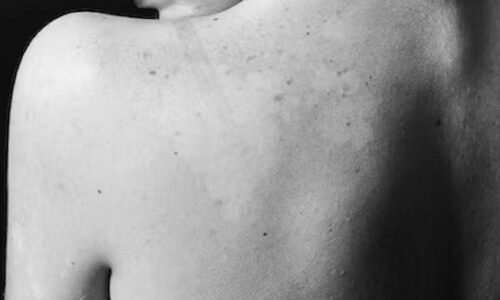
How to Get Rid of Chest Acne
Chest acne, a common skincare concern, can affect individuals of all genders, and females are no exception. While it may not be as prominently discussed as facial acne, chest acne can be equally distressing and impact one’s self-esteem. Fortunately, with a proactive approach and consistent skincare practices, you can effectively manage and eliminate chest acne.
Understanding the Causes
Chest acne, medically termed as acne vulgaris, is a prevalent skin condition characterized by the formation of pimples, blackheads, and whiteheads on the chest area. While the exact cause of chest acne can vary from person to person, several common factors contribute to its development:
- Hormonal Fluctuations: Hormonal imbalances, especially during puberty, menstruation, pregnancy, and menopause, can contribute to chest acne. These fluctuations can lead to increased sebum production, clogging pores and fostering an environment for acne-causing bacteria.
- Skincare Products: The use of comedogenic or pore-clogging skincare products, such as heavy lotions or oils, can exacerbate chest acne. Ensuring that your skincare routine is non-comedogenic is crucial in preventing further breakouts.
- Sweat and Friction: Excessive sweating, coupled with friction from tight clothing, can create a breeding ground for acne. The combination of sweat, dead skin cells, and fabric rubbing against the skin can lead to blocked pores.
- Friction and Pressure: Friction and pressure on the chest area, caused by tight clothing, backpack straps, or sports equipment, can aggravate existing acne lesions and contribute to new breakouts. Prolonged friction can irritate the skin and disrupt the skin’s barrier function, making it more susceptible to inflammation and infection.
- Lifestyle Factors: Certain lifestyle habits can contribute to the development of chest acne. Factors such as poor diet, stress, lack of sleep, and excessive sweating can all impact skin health and exacerbate acne. High-glycemic foods and dairy products, in particular, have been linked to increased acne severity in some individuals.
Prevention Strategies
Preventing requires a comprehensive approach that addresses the underlying causes and triggers of acne breakouts. By incorporating the following prevention strategies into your daily routine, you can minimize the risk of developing chest acne and maintain clear, healthy skin:
- Wear Breathable Fabrics: Opt for loose, breathable fabrics like cotton to reduce friction and allow your skin to breathe. Avoid tight clothing, especially during workouts, to minimize irritation.
- Shower After Exercise: Post-exercise, take a shower to remove sweat and bacteria from your skin. This prevents the accumulation of impurities that could lead to chest acne.
- Choose Non-Comedogenic Products: When selecting skincare and beauty products, prioritize non-comedogenic and oil-free options. Look for products labeled as suitable for sensitive or acne-prone skin.
- Maintain a Consistent Skincare Routine: Develop a regular skincare routine that includes cleansing, toning, and moisturizing. To get rid of pollutants without depleting the skin’s natural oils, use a mild cleanser.
Treatment Options
Treating chest acne involves addressing the underlying causes of acne breakouts and implementing targeted therapies to reduce inflammation, unclog pores, and promote skin healing. Depending on the severity of your chest acne and your individual skin type, various treatment options may be recommended by dermatologists. Here are some effective treatment options for chest acne:
- Topical Treatments: Consider using over-the-counter topical treatments containing ingredients like benzoyl peroxide or salicylic acid. These can help unclog pores and reduce inflammation. It’s essential to introduce these products gradually to avoid skin irritation.
- Prescription Medications: For more severe cases, a dermatologist may prescribe topical or oral medications like retinoids, antibiotics, or hormonal treatments to address underlying causes.
- Exfoliation: Regular exfoliation can help remove dead skin cells that contribute to pore blockages. Choose a gentle exfoliator and incorporate it into your skincare routine once or twice a week.
- Tea Tree Oil: Known for its antibacterial and anti-inflammatory properties, tea tree oil can be applied topically to affected areas. Dilute it with a carrier oil to prevent skin irritation.
Lifestyle Changes to Improve Chest Acne
Making certain lifestyle changes can significantly improve chest acne and prevent future breakouts. By adopting healthy habits and avoiding common triggers, you can support clear, healthy skin. Here are some lifestyle changes to consider:
- Balanced Diet: A well-balanced diet rich in fruits, vegetables, and whole grains can contribute to overall skin health. Limiting dairy and sugary foods may also benefit those prone to acne.
- Hydration: Make sure you drink enough water each day to stay hydrated. Hydrated skin is less prone to inflammation and can better fight against acne.
- Stress Management: Hormonal changes brought on by high stress levels might aggravate acne. Engage in stress-relieving practices like yoga, meditation, or deep breathing.
Conclusion
Banishing requires a multifaceted approach that addresses both external and internal factors. By adopting a consistent skincare routine, making lifestyle adjustments, and seeking appropriate treatments, females can effectively manage and eliminate. Remember that results may vary, and it’s advisable to consult with a dermatologist for personalized advice tailored to your specific skin type and concerns. Embrace the journey to clearer skin with patience and commitment, and you’ll be on your way to a blemish-free chest.
Janvi Dhiman
Janvi Dhiman holds a Master's degree in Biotechnology and has a background in both undergraduate and postgraduate studies from Amity University, Noida. Her passion lies in making meaningful contributions to the healthcare and research sectors. Currently, she is a valued member of our team, serving as a Research Analyst and a medical content writer at DiseaseInfoHub.




